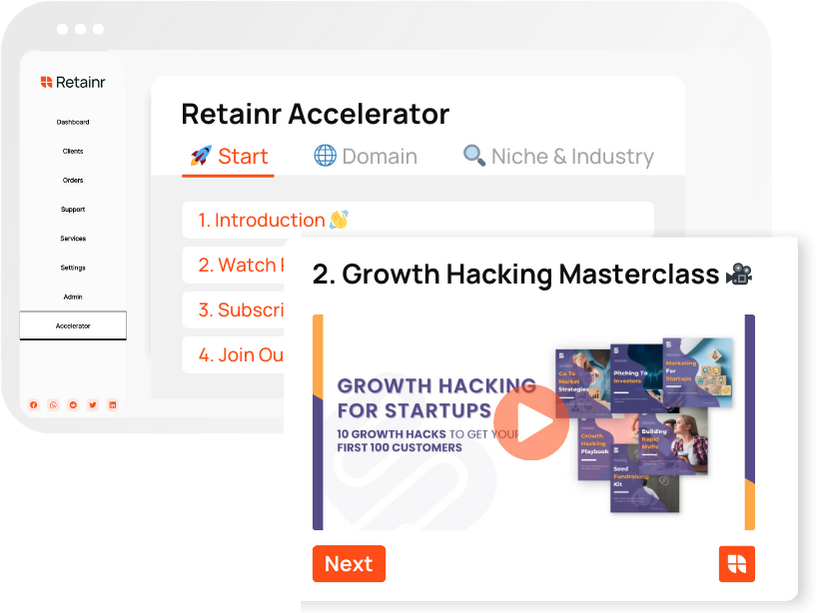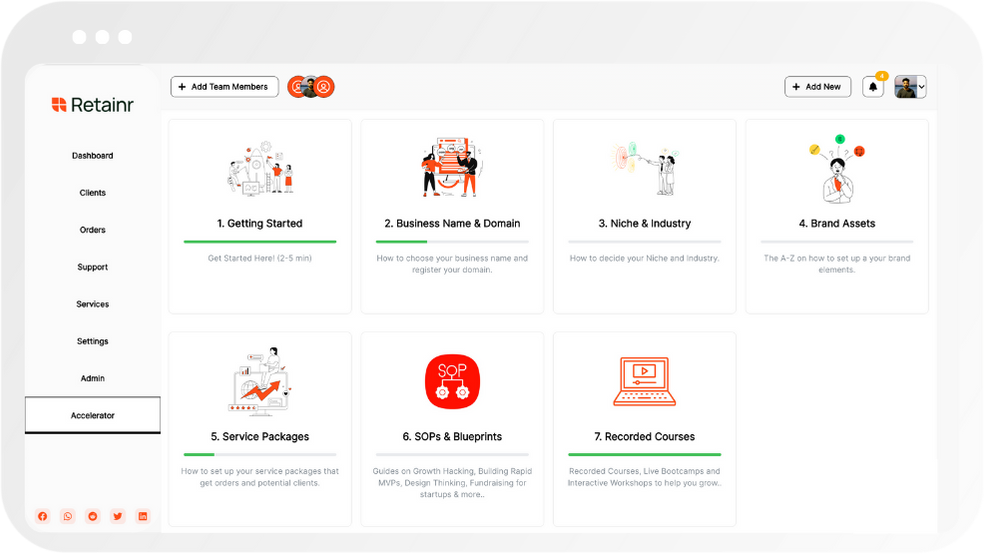
Streamlining Project Planning: Proven Methods for Success
Build with Retainr
Sell your products and services, manage clients, orders, payments, automate your client onboarding and management with your own branded web application.
Get Started1. What are some proven methods for streamlining project planning?
Proven Methods for Streamlining Project Planning
Streamlining project planning is essential to efficiently achieving goals and objectives of any business project. There are a number of proven strategies that can contribute to a successful project plan.
Use of Project Management Tools
Project management tools can help organize tasks, manage resources, and track progress. Tools such as Trello, Asana, Monday.com, and MS Project offer comprehensive features to streamline project planning, including:
- Create and assign tasks
- Set deadlines
- Monitor project progress
- Collaborate within teams
- Generate reports
Effective Strategies for Streamlining Project Planning
Besides technologies, a few strategies can also enhance project planning. Here are three such strategies:
1. SMART Goals: Setting Specific, Measurable, Achievable, Relevant, and Time-bound goals can ensure a structured plan.
| Strategy | Description |
|---|---|
| 2. Risk Management: | Identifying and proactively mitigating risks can prevent delays and resource waste. |
| 3. Regular Reviews: | Consistent monitoring and assessment of the project's progress can help identify potential issues early. |
Implementing these approaches can drastically improve the effectiveness of project planning and execution.
2. How can streamlining improve my project planning process?
Improvement of Efficiency
Streamlining your project planning process introduces a system of operation that encourages efficiency. These systems aim to eliminate unnecessary steps, reduce complexity and ensure smooth transitions. The major ways streamlining can improve your planning process include:
- Enhanced productivity through the elimination of redundant tasks.
- Increased accuracy by reducing the chances of miscommunication or misunderstanding in the process flow.
- Faster decision making as it simplifies the process and makes it easier to analyze.
Cost and Time Effectiveness
There is a significant improvement in cost and time management with streamlined project planning. Efficient execution of tasks reduces the time spent on a project, thereby saving costs. Specifically, streamlining helps in:
- Decreasing project duration: By clarifying roles, reducing time wasted on unproductive tasks and ensuring continuous task execution, the project is completed faster.
- Reducing costs: With decreased time on project execution and reduced labor and resource wastage, overall project costs are significantly reduced.
Improved Quality of Project Output
Streamlined project planning also has a direct impact on the quality of work produced. It ensures that there are fewer errors, and it is easier to track and correct them when they occur. Key improvements include:
| Aspect | Improvement Description |
|---|---|
| Consistency | By standardizing the planning process, outputs become more predictable and consistent. |
| Accuracy | Streamlining reduces the risk of human error, thereby improving the accuracy of the project's results. |
| Customer Satisfaction | Quality output leads to increased satisfaction among stakeholders and end-users, adding value to the project. |
3. What are the key elements of a streamlined project plan?
Key Elements of a Streamlined Project Plan
The fundamental aspect of a streamlined project plan lays in its simplicity, clarity, and efficiency. The three principal elements that make a significant difference in your project planning are: Objectives, Team Roles and Responsibilities, and Project Timeline. Each element is explained below:
Project Objectives
The first and foremost element of a streamlined project plan is clear and concise objectives. These objectives provide a roadmap and direction for the entire project. They should be:
- Specific: clearly define what needs to be accomplished.
- Measurable: establish concrete criteria for measuring progress.
- Attainable: set goals that are achievable within the resources and time available.
- Relevant: align the objectives with your business or strategic goals.
- Time-bound: specify when the goal should be achieved.
Team Roles and Responsibilities
Delegating tasks and defining everyone's role is crucial for a project's success. A clear understanding of their responsibilities prevents overlapping of tasks and promotes optimal productivity. A Responsibility Assignment Matrix (RAM), like the following, can be helpful:
| Team Member | Role | Responsibilities |
|---|---|---|
| Alice | Project Manager | Overseeing the project, coordinating with stakeholders, and managing risks. |
| Bob | Lead Developer | Developing the code, testing the software, and fixing bugs. |
| Charlie | UX Designer | Creating the user interface, prototyping, and iterating designs based on user feedback. |
Project Timeline
The final key element is the timeline outlining the start and end dates of the project. It should also include milestones, which are specific goals or tasks that need to be completed by a particular date. This element helps in tracking progress and keeping everyone on schedule. Use a Gantt chart or similar tool to visibly outline the project schedule.
4. How can I incorporate these methods into my current project planning procedures?
Step One: Incorporating Proven Methods
The first step to incorporating these proven methods into your current project planning procedures is to understand your project's needs. The following are some steps you can follow:
- Identify the project's goals and objectives.
- Estimate the resources needed to achieve these objectives (including time, people, and budget).
- Develop a timeline that clearly outlines when each task or milestone should be achieved.
- Determine potential risks and how to mitigate them.
Step Two: Utilize Technology
Technology can hugely aid in project planning and management. For instance, project management software can help to streamline tasks, manage resources more efficiently, generate reports, and foster better team collaboration. These are some commonly used software:
| Software | Benefits |
|---|---|
| MS Project | Flexible and robust. Offers project scheduling, budgeting and progress tracking. |
| Asana | Easily allows for task management and collaboration. Good for smaller projects with teams. |
| Jira | Designed specifically for software development projects. It helps in planning, tracking and releasing software. |
Step Three: Continual Improvement
Continual improvement is key to incorporating new methods into your project planning procedures. Once you've begun implementing new practices, you need to regularly reassess your progress and make further adjustments if necessary. Included in this step are activities like:
- Regularly review the project's progress against its objectives and adjust the plan as needed.
- Perform a post-mortem review after the project concludes to identify what went well and what could be improved in the future.
- Seek feedback from team members and stakeholders on how the project was managed.
5. What are some common obstacles to streamlining project planning and how can I overcome them?
Common Obstacles to Streamlining Project Planning
Streamlining project planning can significantly improve efficiency and reduce costly errors. However, several common obstacles can hinder the process:
- Inadequate Information: Lack of clear and precise project details can lead to ineffective planning.
- Poor Communication: Inefficient communication within the team can cause misunderstandings and slow project progress.
- Lack of Adaptability: Unwillingness to modify established processes can prevent a project from adapting to changes.
- Resource Constraints: Limited resources like time, manpower or finances may interfere with the realization of project goals.
Overcoming Obstacles to Streamlining Project Planning
Overcoming these obstacles requires strategic decision-making and appropriate measures:
- Accurate Information: Begin with a comprehensive understanding of the project goals, deliverables, and timeline. Use this knowledge to shape your project planning process.
- Effective Communication: Develop open and transparent communication channels within your team. Regular status updates and feedback can prevent misunderstanding and enhance cooperation.
- Embrace Flexibility: Be open to changing project plans based on real-time inputs and feedback. This can help anticipate and handle unexpected changes effectively.
- Optimize Resources: Track resource usage and schedule tasks in a way that optimizes these resources. This will help maintain productivity even with constraints.
Gauging Success in Overcoming Obstacles
Evaluating the success of these measures can be done through specific performance indicators. This can be represented through the table below:
| Obstacle | Measure | Indicators of Success |
|---|---|---|
| Inadequate Information | Project Details Accuracy | Lesser discrepancies between planned and actual project outcomes |
| Poor Communication | Communication Effectiveness | Higher team satisfaction and fewer misunderstandings |
| Lack of Adaptability | Flexibility Index | Quick and effective response to changing project conditions |
| Resource Constraints | Resource Utilization Rate | Better use of available resources and consistent project progress |
6. How does streamlining project planning contribute to project success?
Streamlining Project Planning Impact on Success
Streamlining project planning is a systematic approach to manage projects efficiently and effectively. It significantly contributes to project success for several reasons:
- Boost Efficiency: Streamlining helps to eliminate redundancy and waste, leading to efficient use of resources.
- Improve Communication: Clear, concise project plans streamline communication among all stakeholders, ensuring everyone is on the same page.
- Reduce Risk: Proactively handling potential issues and bottlenecks minimizes the risk of project failure.
- Increase Visibility: Streamlined project planning provides clarity about deadlines, responsibilities, and progress, increasing visibility and control over the project.
Factors Streamlining Project Planning Focuses On
To understand the extent to which streamlining project planning can contribute to project success, let's look at some key aspects this process focuses on:
| Factor | Description |
|---|---|
| Defined Objectives | Objective clarity eliminates confusion, ensuring everyone is clear about project goals. |
| Planning | Proper planning sets the foundation for project success. It involves setting timelines, assigning roles, and allocating resources. |
| Monitoring Progress | Regular updates on the project's overall progress allow for adjustments as needed. |
| Review and Evaluation | Assessing project outcomes against objectives provides learning opportunities for future projects. |
The Weighing Scale Between Streamlined Project Planning and Success
In conclusion, streamlining your project planning is a pivotal element to ensuring project success. The benefits and direct contributions to project success discussed above are exactly why project managers and teams should put time and effort into refining their project planning processes. By focusing on clear objective setting, proper planning, consistent progress monitoring, and reviews and evaluations, these processes set up the project for optimal results.
7. Can you provide some case studies or examples where streamlining project planning led to success?
Case Study 1: Microsoft’s Transformation Project
Microsoft's major transformational project focusing on streamlining its project planning process is a classic example of success. Initially, the tech giant struggled with redundant processes, poor communication, and high costs. Recognizing the need for change, the company implemented a streamlined approach:
- Replaced multiple project management tools with a single system.
- Combine tasks and resources units into a unified framework.
- Established clear communication channels among team members and stakeholders.
Post-implementation, Microsoft saw a significant reduction in project completion times and costs. Furthermore, team collaboration and productivity improved tremendously.
Case Study 2: Porsche’s Production System
Porsche’s Production System (PPS) is a remarkable case highlighting the benefits of streamlining project planning. The leading car manufacturing company tackled several challenges such as high production expenses, inefficiencies, and delays by:
- Introduction of a standardized yet flexible project management approach.
- Implementation of just-in-time and just-in-sequence concepts.
- Continuous process improvements with feedback.
As a result, Porsche experienced a rise in its overall production efficiency, improved worker morale, and reduced overhead costs.
Comparison Table
| Company | Pre-Streamlining Challenges | Streamlining Solutions | Post-Streamlining Benefits |
|---|---|---|---|
| Microsoft | Redundant Processes, Poor Communication, High Costs | Unified System, Combined Tasks, Clear Communication Channels | Reduced Completion Time, Lower Costs, Enhanced Team Collaboration |
| Porsche | High Production Expenses, Inefficiency, Delays | Standardized Management, JIT and JIS Concepts, Continuous Process Improvements | Improved Production Efficiency, Boosted Worker Morale, Lower Overheads |
8. How can streamlining project planning benefit team communication and collaboration?
Benefits to Team Communication with Streamlined Project Planning
Streamlining project planning is an efficient approach that significantly enhances team communication in several ways. The following are the key advantages:
- Clarity: Clear and concise project plans eliminate chances of confusion or misunderstandings about the project tasks or objectives.
- Transparency: When the roadmap for a project is well-defined, it's easier for team members to understand their roles and responsibilities, leading to better transparency.
- Coherency: Streamlined project planning ensures a unified understanding of the project's goals among the team members, thus promoting coherency in their collective actions.
Enhancing Collaboration through Streamlined Project Planning
Knowing the project's direction and having clarified roles within the project can inspire team members to actively participate and cooperate more. Here's how streamlining project planning fosters collaboration:
- Shared Vision: A well-defined project plan can foster unity and commitment among team members towards accomplishing a shared vision.
- Eliminates Redundancy: Clearly outlined project plans help in identifying duplicate tasks and thus prevents repetition, thereby saving effort and time for team members.
- Conflict Resolution: By creating clear boundaries of responsibility and deliverables, streamlined project planning can prevent possible conflicts, thereby promoting harmony within the team.
Summary of Team Communication and Collaboration Benefits
| Benefits | Team Communication | Team Collaboration |
|---|---|---|
| Clarity | ✔️ | ✔️ |
| Transparency | ✔️ | ✔️ |
| Coherency | ✔️ | ✔️ |
| Shared Vision | ✔️ | |
| Eliminates Redundancy | ✔️ | |
| Conflict Resolution | ✔️ |
9. Does streamlining project planning often require investment in new technology or software?
Investments in New Technology or Software
Streamlining project planning does not necessarily require investment in new technology or software, but it can certainly benefit from it. Much depends on the current state of your project management systems and processes, and the specific needs of your organization. In many cases, the move towards more streamlined project planning could involve the adoption of new approaches powered by modern technologies.
- Project Management Software: Tools like Asana, Trello, or Microsoft Project, can significantly enhance project planning. They enable the easy tracking of project progression, task allocation, time management, and communication.
- Collaboration Tools: Software like Slack or Microsoft Teams is essential for effective communication among project team members, a key aspect of streamlined project planning.
- Cloud Technology: Cloud-based platforms allow for real-time updates, ease of access from any location, and improved collaboration.
Cost Considerations
While these new technologies may require capital, they might lead to greater efficiencies, better results, and eventually cost savings. However, organizations must weigh the potential benefits against the expenses. The following table provides an idea of the potential costs versus benefits:
| Technology | Potential Cost | Potential Benefit |
|---|---|---|
| Project Management Software | $10 - $150 per user per month | Improved project tracking, better resource allocation, improved communication |
| Collaboration Tools | $8 - $20 per user per month | Effective team communication, improved collaboration, better task allocation |
| Cloud Technology | Variable depending on the scale of usage | Real-time updates, easy access from any location, improved collaboration |
Conclusion
While the initial investment can seem substantial, the payback in terms of efficiency, productivity, and streamlined project execution can make it worthwhile. The decision to invest in new technology or software for streamlining project planning must be made after careful consideration of the current needs, potential benefits, and costs. Ultimately, technological investment is a strategic decision that should align with the organization's broader goals and objectives.
10. Can these methods of streamlining project planning be applied to project management in any industry?
Application of Streamlining Methods Across Industries
The strategies for streamlining project planning are not industry-specific. Instead, they are a series of best practices that can be adapted and applied to any industry, so long as they involve project management. According to a study published in the International Journal of Project Management, over 90% of projects that utilized these strategies reported improved efficiency and success rates.
List of Industries and Their Unique Needs
- Manufacturing: Including process optimization, lean principles, and quality control measures
- Construction: Focusing on budget control, timeframe management, and safety protocols
- IT: Paying attention to software development life cycles, agile management, and continuous integration
- Healthcare: Adapting to regulatory compliance, patient safety, and quality care initiatives
Regardless of the industry, these methods can be adapted to suit specific needs and goals, thus ensuring a successful project delivery.
Table Illustrating the Application of these Methods to Different Industries
| Industry | Applicable Streamlining Method |
|---|---|
| Manufacturing | Process optimization, Lean Principles |
| Construction | Timeframe management, Safety Protocols |
| IT | Agile Management, Continuous Integration |
| Healthcare | Regulatory Compliance, Patient Safety |
In summary, the methods of streamlining project planning provide a flexible framework that can be applied universally across industries to improve project management outcomes.
Conclusion
Streamlining Project Planning: Proven Methods for Success
Efficient project planning is a critical aspect for the success of any project. It involves setting objectives, defining roles, and anticipating potential challenges. Ultimately, this helps to avoid missed deadlines and ensures the project is completed successfully and effectively.
We discussed the following proven methods to streamline project planning:
- Clear Communication: Ensuring everyone involved in the project is aware of the objectives and their individual responsibilities is crucial.
- Detailed Planning: This involves scheduling of tasks and allocating resources appropriately. It also includes anticipating any potential risks and planning for them.
- Regular Monitoring: Regular progress monitoring is needed to make sure the project is on track and any issues are identified early.
- Using Right Tools: Utilising the right tools can also help to streamline project planning, making the overall process much smoother.
Speaking of the right tools, one of the powerful tools that can revolutionize your project planning process is Retainr.io, a whitelabel software designed to Sell, Manage Clients, Orders & Payments with Your Own Branded App.
With Retainr.io, you'll have a complete, professional business management platform that simplifies all aspects of project planning. From selling to client management, from order handling to payment processing, Retainr.io incorporates a broad array of features to facilitate a streamlined, efficient project planning process.
Discover Retainr.io today, and upgrade your project planning process.
Boost Your Agency Growth
with Retainr Accelerator
Uncover secrets, strategies, and exclusive blueprints to take your agency's growth to the next level — from marketing insights to effective presentations and leveraging technology.

SOPs, Cheatsheets & Blueprints
Leverage 50+ SOPs (valued over $10K) offering practical guides, scripts, tools, hacks, templates, and cheat sheets to fast-track your startup's growth.
Connect with fellow entrepreneurs, share experiences, and get expert insights within our exclusive Facebook community.
.jpg)

Join a thriving community of growth hackers. Network, collaborate, and learn from like-minded entrepreneurs on a lifelong journey to success.

Gain expertise with recorded Courses, Live Bootcamps and interactive Workshops on topics like growth hacking, copywriting, no-code funnel building, performance marketing and more, taught by seasoned coaches & industry experts.

.jpg)

.jpeg)


